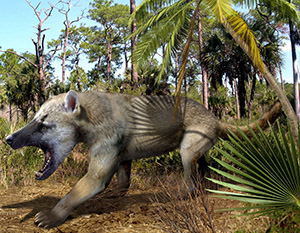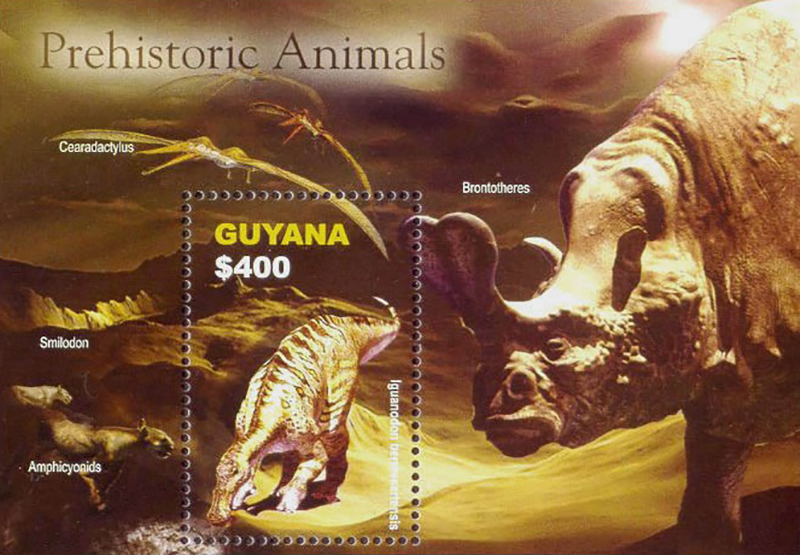Amphicyon sp.

(Da: enwikipedia.org)
Phylum: Chordata Haeckel, 1874
Subphylum: Vertebrata Cuvier, 1812
Classe: Mammalia Linnaeus, 1758
Ordine: Carnivora Bowdich, 1821
Famiglia: Amphicyonidae Haeckel, 1886
Genere: Amphicyon Lartet, 1836
Specie e sottospecie
Tra le varie specie di anficione, da ricordare l'europea Amphicyon major, rinvenuta in Francia e anche in Italia, e varie specie nordamericane. Nel Nebraska e nel Colorado sono note A. galushai, A. frendens e la gigantesca A. ingens, tutte risalenti a un periodo compreso tra 18,8 e 14,2 milioni di anni fa.
Descrizione
Come indica il nome comune, l'anficione presenta alcune caratteristiche che richiamano i cani e altre che lo avvicinano agli orsi. Il nome scientifico, invece, significa più o meno “cane ambiguo”. Decisamente robusto, l'anficione raggiungeva i due metri di lunghezza; la specie più grande, l'Amphicyon ingens, assomigliava molto più a un orso che a un cane. Possedeva una coda lunga e pesante, un collo potente, zampe robuste e una dentatura simile a quella del lupo. Probabilmente era un onnivoro e il suo stile di vita era forse simile a quello di un orso bruno, anche se con abitudini maggiormente predatorie.
Diffusione
Mammiferi estinti, noti comunemente come “cani – orsi”. Vissero nel corso dell'Oligocene e nel Miocene inferiore (tra 30 e 14 milioni di anni fa). I loro resti sono stati ritrovati in gran parte d'Europa, in Asia e in Nordamerica.
Bibliografia
–Hunt, Robert M. (2003). "Intercontinental Migration of Large Mammalian Carnivores: Earliest Occurrence of the Old World Beardog Amphicyon (Carnivora, Amphicyonidae) in North America" (PDF). Bulletin of the American Museum of Natural History. 279: 77-115.
–"Fossilworks: Amphicyon". fossilworks.org.
–Legendre, S.; Roth, C. (1988). "Correlation of carnassial tooth size and body weight in recent carnivores (Mammalia)". Historical Biology. 1 (1): 85-98.
–Sorkin, B. (2008-04-10). "A biomechanical constraint on body mass in terrestrial mammalian predators". Lethaia. 41 (4): 333-347.
–Rafael Fraguas (January 7, 2010). "Animales prehistóricos en el Metro". El País (in Spanish). Madrid.
–"Fossilworks: Amphicyon major". fossilworks.org.
–National Geographic Prehistoric Mammals by Alan Turner.
–Figueirido; et al. (2011). "Body mass estimation in amphicyonid carnivoran mammals: A multiple regression approach from the skull and skeleton" (PDF). Acta Palaeontologica Polonica. 56 (2): 225-246.
–Hunt, Robert M. (1998). "Amphicyonidae". In Janis, C. M.; Scott, K.M.; Jacobs, L. L (eds.). Evolution of tertiary mammals of North America, volume 1: Terrestrial carnivores, ungulates and ungulatelike mammals. Cambridge, UK: Cambridge University Press. pp. 196-227. ISBN 978-0521355193.
–Pickford; et al. (1996). "Preliminary results of new excavations at Arrisdrift, middle Miocene of southern Namibia". C. R. Acad. Sci. Paris. II (332): 991-996.
–Catalogue of the Fossil Mammalia in the British Museum Natural History, Dept. of Geology, Richard Lydekker.
–M. T. Antunes; et al. (2006). "Ichnological evidence of a Miocene rhinoceros bitten by a bear-dog (Amphicyon giganteus)". Annales de Paléontologie. 92: 31-39.
–W. D. Matthew. 1924. Third contribution to the Snake Creek Fauna. Bulletin of the American Museum of Natural History 50: 59-210
–Sorkin, B. (2006). "Ecomorphology of the giant bear-dogs Amphicyon and Ischyrocyon". Historical Biology. 18 (4): 375-388.
–Peigné, Stéphane (2006). "A new amphicyonid (Mammalia, Carnivora, Amphicyonidae) from the late middle Miocene of northern Thailand and a review of the amphicyonine record in Asia". Thailand Journal of Asian Earth Sciences. 26 (5): 519-532.

|
Data: 24/01/2005
Emissione: Animali preistorici Stato: Guyana Nota: Presente nel foglietto |
|---|